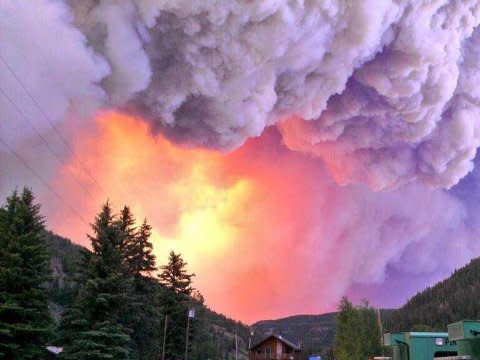AMERICA IS BURNING: Severe Drought Causes Rash Of Major Wildfires

Twitter/pikehotshots
The South Fork fire in Colorado.
Wildfires are a yearly occurrence in the western U.S., but they have been especially bad this year.
Sunday night, an Arizona wildfire killed 19 firefighters and destroyed half the structures in Yarnell, a town of 700 residents. The fire, which is still raging, has been deadliest U.S. wildfire involving firefighters in the past 30 years at least.
Last month, the Black Forest fire in Colorado killed two people and destroyed nearly 500 homes. It was the most destructive wildfire in the state's history. The state was ravaged by other fires this season as well — one fast-moving fire threatened to destroy an entire town.
New Mexico and California have also seen massive wildfires this year.
The Atlantic Wire published graphs that show that wildfires have gotten bigger throughout the past decade.
The deadly blazes are partly the result of a major drought mostly affecting the western half of the U.S. , according to the U.S. Drought Monitor. The past year has been the driest on record for New Mexico and California, and Arizona's drought conditions have worsened this week. Conditions in Colorado are also continuing to deteriorate from the high heat.
Most of California, Colorado, Arizona, and New Mexico are experiencing drought conditions that range from "severe" to "exceptional," according to the U.S. Drought Monitor.
A forest ecologist at Colorado State University told The Watch newspaper in Telluride that drought was to blame for the West Fork Complex fire that hit an area of Colorado that's usually not vulnerable to large-scale, destructive wildfires.
He told the newspaper that the fire was "drought-driven," and also linked the fire to unusual conditions linked to climate change.
"That area is experiencing extreme drought, low snowpack, late onset of winter, early snowmelt and warmer springs and summers," said Jason Sibold, the university ecologist. "A lot of those places, in the old climate scenario, would still be under snow. There’s no way they would be burning."
A record-breaking heat wave last month in the West made drought conditions worse. Denver had its earliest 100-degree day on June 12, according to the Yakima Herald.
This year's rash of wildfires may just be starting, as the hottest days of summer usually run from July 3 to August 11, and high temperatures can make dry areas especially susceptible to fires.
More From Business Insider

 Yahoo Finance
Yahoo Finance 